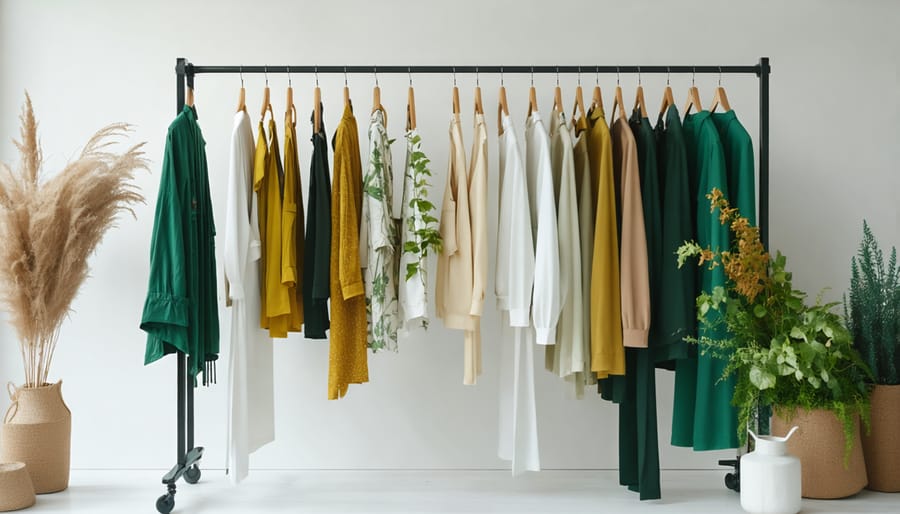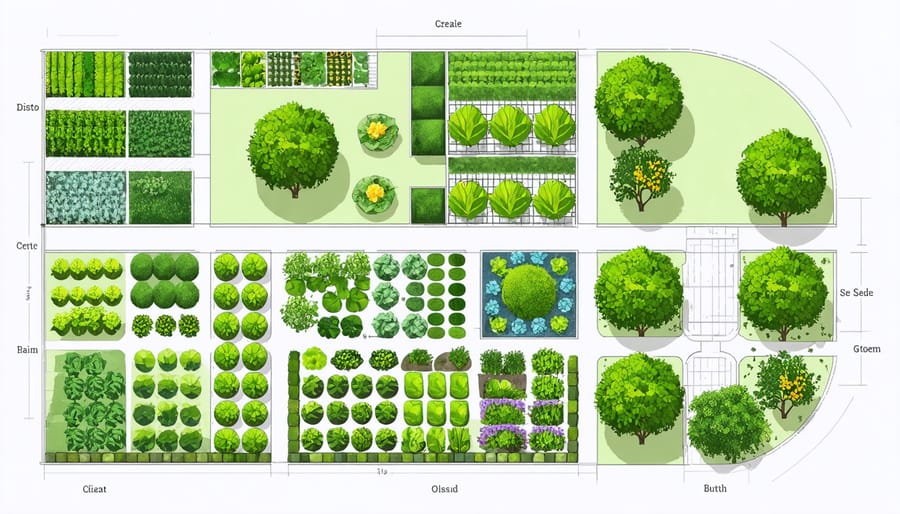Transform Your Wardrobe: Smart Eco-Fashion That Saves Money and the Planet
Transform your wardrobe into an eco-conscious statement by choosing organic cotton, hemp, and recycled polyester garments that minimize environmental impact while maximizing style. Smart consumers now demand transparency in fashion supply chains, driving a revolution where sustainable practices meet contemporary design. The fashion industry accounts for 10% of global carbon emissions, but a new wave of innovative designers, ethical manufacturers, and conscious shoppers is reshaping how we think about clothing.
Local thrift stores, clothing swaps, and sustainable boutiques offer accessible entry points into eco-friendly fashion, proving that style and sustainability can coexist beautifully. By embracing timeless pieces, supporting ethical brands, and maintaining garments properly, anyone can build a wardrobe that reflects both personal style and environmental values.
Shop with purpose, invest in quality, and consider each purchase’s environmental impact – these simple shifts create lasting change in the fashion industry while building a more sustainable future for all.
Natural Fabrics That Love Your Skin and the Earth

Organic Cotton and Hemp Heroes
Organic cotton and hemp are leading the charge in sustainable fashion, offering eco-conscious consumers excellent alternatives to conventional fabrics. Organic cotton is grown without harmful pesticides and requires significantly less water than traditional cotton, making it a planet-friendly choice that’s gentle on sensitive skin.
Hemp stands out as a particularly impressive natural fiber, requiring minimal water and no pesticides to grow. This hardy plant actually improves soil health and can produce four times more fiber per acre than cotton. Hemp fabric becomes softer with each wash while maintaining impressive durability, making it perfect for everything from casual wear to workwear.
Both materials breathe well and have natural antimicrobial properties, reducing the need for frequent washing. They’re also biodegradable, ensuring your clothing won’t contribute to landfill waste at the end of its lifecycle. Local farmers are increasingly growing these sustainable crops, creating economic opportunities while supporting eco-friendly fashion choices.
When shopping, look for certification labels like GOTS (Global Organic Textile Standard) to ensure you’re getting genuine organic materials that support sustainable farming practices.
Innovative Plant-Based Materials
The fashion industry is experiencing a remarkable transformation with the emergence of innovative plant-based materials that are both sustainable and stylish. Bamboo fabric has become a standout choice, offering natural antibacterial properties and exceptional breathability while requiring minimal water for cultivation. This versatile material feels luxuriously soft against the skin and naturally regulates temperature.
Eucalyptus-derived fabrics, particularly Tencel Lyocell, are making waves for their silky texture and eco-friendly production process. These materials use significantly less water than traditional cotton and are produced in a closed-loop system that recycles water and solvents.
Other exciting innovations include cork fabric, which provides a leather-like alternative harvested sustainably from cork oak trees, and pineapple leather (Piñatex), created from pineapple leaf fibers that would otherwise go to waste. Seaweed-based fabrics are also emerging, offering natural UV protection and releasing nutrients beneficial for skin health.
These materials not only reduce environmental impact but also provide unique textures and properties that conventional fabrics can’t match, proving that sustainable fashion doesn’t require compromise on quality or style.
Simple Switches for a Sustainable Closet

Quality Over Quantity
When building an eco-friendly wardrobe, embracing the “less is more” philosophy is essential. Instead of filling your closet with fast fashion pieces that quickly lose their appeal, invest in high-quality garments that stand the test of time. Look for well-constructed items made from durable natural materials like organic cotton, hemp, and wool. These fabrics not only last longer but often come with sustainable packaging choices from conscious brands.
Consider creating a capsule wardrobe with versatile pieces that can be mixed and matched effortlessly. Choose classic cuts and timeless designs over trendy items that may feel outdated next season. Pay attention to stitching quality, fabric weight, and construction details when shopping. A well-made garment might cost more initially but will outlast several cheaper alternatives, reducing both environmental impact and long-term expenses.
Before purchasing, ask yourself if the item will remain in your rotation for at least 30 wears. This simple rule helps prevent impulse buying and ensures each piece earns its place in your wardrobe. Look for clothing with care labels indicating proper maintenance methods, and choose items that can be easily repaired if needed. Remember, the most sustainable garment is the one you already own and maintain well.
Second-Hand Success
Thrift shopping is both an art and an adventure, and with the right approach, you can build a sustainable wardrobe filled with unique, high-quality pieces. Start by researching the best thrift stores in your area, particularly those in upscale neighborhoods which often receive higher-end donations. Before shopping, create a list of wardrobe essentials you’re seeking to avoid impulse purchases.
When examining second-hand clothing, pay special attention to material quality and construction. Check seams for loose threads, ensure zippers work smoothly, and examine buttons for security. Natural fibers like cotton, wool, and silk tend to hold up better over time than synthetic materials. Hold items up to natural light to spot any thin spots or hidden stains.
Visit consignment shops and online marketplaces for designer pieces at fraction of their original cost. Many online platforms now specialize in authenticated luxury items, making high-end sustainable fashion more accessible. Consider joining local buy-nothing groups or organizing clothing swaps with friends for a cost-free way to refresh your wardrobe.
Don’t overlook alterations – a well-fitted second-hand piece can look custom-made. Simple adjustments like hemming pants or taking in a waist can transform an okay find into a perfect addition to your wardrobe. Remember to wash or dry clean items before adding them to your closet, and always check care labels to ensure proper maintenance of your sustainable fashion finds.
Care Techniques That Extend Garment Life
Natural Cleaning Solutions
Keeping your eco-friendly wardrobe in top condition doesn’t require harsh chemicals. Creating your own eco-friendly cleaning solutions from simple household ingredients can effectively clean and maintain your sustainable fashion pieces while protecting the environment.
For everyday stains, mix equal parts white vinegar and water in a spray bottle. This natural solution works wonders on most fabrics and helps eliminate odors. Baking soda creates an excellent gentle scrub for tough spots – simply make a paste with water and apply it to the stained area.
To freshen up delicate natural fibers, try a mixture of lemon juice and water. The citric acid naturally brightens fabrics while leaving a fresh scent. For wool and other animal-based fibers, mix one part gentle castile soap with eight parts water for a mild yet effective cleanser.
Keep a small jar of dried lavender or cedar chips in your closet as a natural alternative to mothballs. These aromatics not only protect your clothes but also add a pleasant natural fragrance. For boots and shoes, sprinkle baking soda inside overnight to absorb moisture and odors without harmful chemicals.
Remember to always test any cleaning solution on a small, hidden area first to ensure fabric compatibility.

Repair and Refresh
Learning basic mending skills can significantly extend the life of your favorite garments while reducing textile waste. Start with simple repairs like sewing on buttons, fixing small tears, and patching holes. Keep a basic sewing kit handy with needles, thread in common colors, scissors, and spare buttons from your clothes.
Get creative with upcycling by transforming outdated pieces into fresh favorites. Turn old jeans into trendy shorts or a denim bag, convert oversized t-shirts into tank tops, or transform a maxi dress into a fashionable skirt. Even stained clothing can find new life – try natural dye techniques using kitchen scraps like onion skins or avocado pits to refresh faded items.
Consider hosting clothing swap parties with friends to refresh your wardrobe sustainably. Before discarding any garment, ask yourself if it could be repaired, reimagined, or repurposed. Local tailors and repair cafes can help with more complex fixes, while online tutorials offer endless inspiration for DIY projects.
Remember, maintaining your clothes properly from the start helps prevent damage. Follow care labels, wash in cold water when possible, and air dry when you can to keep your eco-friendly fashion choices looking their best longer.
Local Fashion Heroes
In every community, there are passionate artisans and designers working tirelessly to create sustainable fashion alternatives. When you support local businesses, you’re not just getting unique, handcrafted pieces – you’re investing in your community’s sustainable future.
Take Sarah Chen, for instance, who transforms discarded denim into stunning patchwork jackets at her Vancouver studio. Or consider the Indigenous-owned collective in Toronto that creates contemporary wear using traditional, sustainable materials and techniques passed down through generations.
Many local fashion heroes are embracing innovative approaches to sustainability. The Montreal-based Textile Revival Project collects pre-loved fabrics from the community and turns them into limited-edition collections. In Halifax, The Green Seamstress offers repair workshops, teaching valuable skills that extend clothing life while building community connections.
These local initiatives often go beyond just creating clothes. They’re educational hubs, teaching proper garment care, hosting swap meets, and organizing repair cafés. By choosing these local makers, you’re not only getting thoughtfully crafted pieces but also becoming part of a movement that values quality over quantity, creativity over mass production, and community over convenience.
Making sustainable fashion choices doesn’t have to be complicated or expensive. By focusing on quality over quantity, choosing eco-friendly materials, and supporting ethical brands, we can all contribute to a more sustainable fashion industry. Remember to invest in timeless pieces, care for your clothes properly, and consider second-hand shopping as a fantastic alternative to fast fashion. Small changes in our shopping habits can make a significant impact on the environment. Start your sustainable fashion journey today by implementing these simple strategies, and remember that every conscious choice helps create a more sustainable future for the fashion industry. Together, we can build a wardrobe that’s both stylish and environmentally responsible.





